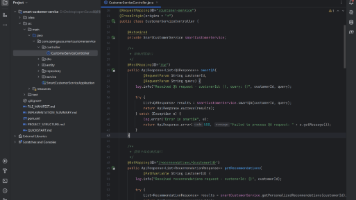Canvas实现以鼠标当前位置为原点缩放及画布拖动(矩阵变换)
通过矩阵的方式用 Canvas 实现以鼠标当前位置为原点缩放及画布拖动,理解起来更加容易(当然前提是要有一定的数学基础,起码了解过矩阵🤣),大大减少了代码量,同时缩放和拖拽的逻辑可以复用,不仅是在Canvas中,普通的div拖拽和放大也是一样的代码逻辑。
本文首发于「前端架构师笔记」: https://mp.weixin.qq.com/s/xO4pq0TjTlzW1_166kQheA
前言
在之前的Canvas鼠标滚轮缩放以及画布拖动(图文并茂版)一文中我曾经介绍过一种实现鼠标滚轮缩放及画布拖动的方法,这种方式利用的是Canvas的api进行缩放和拖动,并且实现原理理解起来也比较抽象。
本文将介绍一种更加便捷、通用的方式来实现鼠标滚轮缩放及画布拖动的方式,这就是矩阵变换。
矩阵变换
矩阵变换就是一种坐标系的转换,因此在图形学中,就会使用矩阵变换来进行图形的变化,比如平移、缩放、旋转。接下来我会重点介绍本文所涉及到的平移和缩放变换。
平移
假设有一个点 P(x, y),平移到点 P'(x1, y1),在水平方向位移 dx,垂直方向的位移 dy,那么就可以得到如下公式:
x 1 = x + d x y 1 = y + d y x1 = x + dx \\ y1 = y + dy x1=x+dxy1=y+dy
如果将上述变换公式转换为矩阵变换的形式可以得到如下矩阵变换公式:
[ 1 0 d x 0 1 d y 0 0 1 ] [ x y 1 ] = [ x + d x y + d y 1 ] \left[ \begin{matrix} 1 & 0 & dx \\ 0 & 1 & dy \\ 0 & 0 & 1 \end{matrix} \right] \left[ \begin{matrix} x \\ y \\ 1 \end{matrix} \right]= \left[ \begin{matrix} x+dx \\ y+dy \\ 1 \\ \end{matrix} \right] 100010dxdy1 xy1 = x+dxy+dy1
在坐标系中,一个点就相当于一个向量,从 P 点到 P' 点的变换可以通过:
变换矩阵 ∗ P 点 = P ′ 点 变换矩阵 * P点 = P'点 变换矩阵∗P点=P′点
的形式来表达。
A = [ 1 0 d x 0 1 d y 0 0 1 ] A = \left[ \begin{matrix} 1 & 0 & dx \\ 0 & 1 & dy \\ 0 & 0 & 1 \end{matrix} \right] A= 100010dxdy1
A矩阵就是平移的变换矩阵。
三维矩阵
上面的变换矩阵我们采用的是一个三维矩阵,很多人应该会有疑问:
既然是表达一个二维坐标变换,为什么不用二维矩阵来表达呢?
答案是: 二维矩阵无法表达。
举个例子:
假设我们想把 (0, 0) 这个点移动到 (2, 3),如果用二维矩阵来表达,是这样的:
[ 1 2 0 3 ] [ 0 0 ] = [ 0 0 ] \left[ \begin{matrix} 1 & 2 \\ 0 & 3 \\ \end{matrix} \right] \left[ \begin{matrix} 0 \\ 0 \end{matrix} \right]= \left[ \begin{matrix} 0 \\ 0 \\ \end{matrix} \right] [1023][00]=[00]
发现无论如何也得不到我们想到的结果,因为0与任何数相乘都为0。
如果想表达二维坐标的变换,至少用三维矩阵来表达,同样,如果在三维坐标系中(WebGL),那么至少需要四维矩阵才能表达。
缩放
假设有一个点 P(x, y),沿水平方向缩放 m 倍,沿垂直方向缩放 n 倍之后,得到点 P'(x1, y1),那么就可以得到如下公式:
x 1 = x ∗ m y 1 = y ∗ n x1 = x * m \\ y1 = y * n x1=x∗my1=y∗n
如果将上述变换公式转换为矩阵变换的形式可以得到如下矩阵变换公式:
[ m 0 0 0 n 0 0 0 1 ] [ x y 1 ] = [ m ∗ x n ∗ y 1 ] \left[ \begin{matrix} m & 0 & 0 \\ 0 & n & 0 \\ 0 & 0 & 1 \end{matrix} \right] \left[ \begin{matrix} x \\ y \\ 1 \end{matrix} \right]= \left[ \begin{matrix} m*x \\ n*y \\ 1 \\ \end{matrix} \right] m000n0001 xy1 = m∗xn∗y1
从 P 点到 P' 点的变换可以通过:
变换矩阵 ∗ P 点 = P ′ 点 变换矩阵 * P点 = P'点 变换矩阵∗P点=P′点
的形式来表达。
A = [ m 0 0 0 n 0 0 0 1 ] A = \left[ \begin{matrix} m & 0 & 0 \\ 0 & n & 0 \\ 0 & 0 & 1 \end{matrix} \right] A= m000n0001
A矩阵就是缩放的变换矩阵。
平移&缩放
前面我们分别讨论了平移和缩放的场景下,矩阵的变换方式,那如果想要实现本文的目标——以鼠标当前位置为原点缩放,就需要同时用到平移和缩放变换了。
假如一个二维坐标系存在两个坐标点,A(-2,0) 和 B(2,0)。
如果沿水平方向放大2倍,即 A 和 B 的水平坐标值都乘以放大系数2,得到新的坐标A'(-4,0) 和 B'(4,0)。
如果想要以B点放大中心,确保放大后的B'和B保持重合,需要将放大后的图形整体向左移动一段距离,距离为 B 和 B‘之间水平距离,根据数学公式中两点之间的距离公式,B 和 B‘之间水平距离为 B‘ 的水平坐标减去 B 的水平坐标。
进一步抽象计算公式:
如果 B(x,0),沿水平方向放大 n 倍之后,得到 B’(n*x,0),那么两点间的距离为 n*x-x,又因为是向左移动,上述距离需要取反,即 x-n*x,提取公因式之后得到最终水平方向的偏移值为 x(1-n)。此公式同样适用于垂直方向的缩放。
理解了以某一个点进行缩放的原理之后,我们就可以得到以下矩阵变换公式:
[ m 0 x ( 1 − m ) 0 m y ( 1 − m ) 0 0 1 ] [ x y 1 ] = [ m ∗ x + x ( 1 − m ) m ∗ y + y ( 1 − m ) 1 ] \left[ \begin{matrix} m & 0 & x(1-m) \\ 0 & m & y(1-m) \\ 0 & 0 & 1 \end{matrix} \right] \left[ \begin{matrix} x \\ y \\ 1 \end{matrix} \right]= \left[ \begin{matrix} m*x+x(1-m) \\ m*y+y(1-m) \\ 1 \\ \end{matrix} \right] m000m0x(1−m)y(1−m)1 xy1 = m∗x+x(1−m)m∗y+y(1−m)1
变换矩阵A即为以某一个点进行缩放的变换矩阵。
A = [ m 0 x ( 1 − m ) 0 m y ( 1 − m ) 0 0 1 ] A=\left[ \begin{matrix} m & 0 & x(1-m) \\ 0 & m & y(1-m) \\ 0 & 0 & 1 \end{matrix} \right] A=
m000m0x(1−m)y(1−m)1
glMatrix
在矩阵变换过程中会频繁涉及到矩阵的一些操作,特别是矩阵的乘法,可以使用glMatrix库,帮助我们简化矩阵的计算过程。
如果计算两个矩阵相乘:
const out = new Float32Array([
0, 0, 0,
0, 0, 0,
0, 0, 0,
]);
const o = new Float32Array([
1, 0, 0,
0, 1, 0,
0, 0, 1,
]);
const t = new Float32Array([
3, 0, 0,
0, 3, 0,
0, 0, 3,
]);
const nv = mat3.multiply(out, t, o);
使用 glMatrix 库进行矩阵计算的时候有一点要注意:
This may lead to some confusion when referencing OpenGL documentation, however, which represents out all matricies in column-major format
glMatrix 文档中强调,glMatrix 是以列为主的格式。也就是说一个矩阵,在 glMatrix 中会变成矩阵的转置进行计算。
A = [ 1 0 0 0 0 1 0 0 0 0 1 0 x y z 0 ] A=\left[ \begin{matrix} 1 & 0 & 0 & 0 \\ 0 & 1 & 0 & 0 \\ 0 & 0 & 1 & 0 \\ x & y & z & 0 \\ \end{matrix} \right] A= 100x010y001z0000
在输入到 glMatrix 中会转换为 A的转置进行计算:
A = [ 1 0 0 x 0 1 0 y 0 0 1 z 0 0 0 0 ] A=\left[ \begin{matrix} 1 & 0 & 0 & x \\ 0 & 1 & 0 & y \\ 0 & 0 & 1 & z \\ 0 & 0 & 0 & 0 \\ \end{matrix} \right] A= 100001000010xyz0
代码实现
实现拖拽
e.movementX 和 e.movementY 记录了鼠标水平方向和垂直方向两次移动之间的距离。t 是变换矩阵,注意这里的矩阵 t 用 Float32Array 类型表示,并且输入到 glMatrix 中参与计算时需要变为 t 的转置(前文已经介绍,glMatrix 是以列为主的格式)。
onMousemove(e) {
const { movementX, movementY } = e;
const t = new Float32Array([
1, 0, 0,
0, 1, 0,
movementX, movementY, 1,
]);
this.matrix = this.refresh(this.matrix, t);
}
每次移动之后,调用 refresh 方法,利用 glMatrix.mat3.multiply 方法重新计算移动之后的矩阵值,通过 ctx.transform 方法来更新视图。
refresh(o, t) {
const out = new Float32Array([
0, 0, 0,
0, 0, 0,
0, 0, 0,
]);
const calc = glMatrix.mat3.multiply(out, t, o);
this.ctx.save();
this.ctx.clearRect(0, 0, this.width, this.height);
this.ctx.transform(calc[0], calc[3], calc[1], calc[4], calc[6], calc[7]);
this.draw();
this.ctx.restore();
return calc;
}
实现以鼠标当前位置为原点缩放
鼠标滚轮事件触发时,通过 event.deltaY 值来判断是放大还是缩小,放大超过最大值或者缩小低于最小值时则停止缩放。
以鼠标当前位置为原点缩放的关键是在缩放的同时需要考虑偏移量,水平方向的偏移量为 clientX * (1 - zoom),垂直方向的偏移量为 clientY * (1 - zoom)。
onMousewheel(e) {
e.preventDefault();
const { clientX, clientY, deltaY } = e;
const zoom = 1 + (deltaY < 0 ? this.scaleStep : -this.scaleStep);
this.scale = parseFloat((this.scale * zoom).toFixed(2));
if (this.scale < this.minScale) {
this.scale = this.minScale;
return;
} else if(this.scale > this.maxScale) {
this.scale = this.maxScale;
return;
}
const x = clientX * (1 - zoom);
const y = clientY * (1 - zoom);
const t = new Float32Array([
zoom, 0, 0,
0, zoom, 0,
x, y, 1,
]);
this.matrix = this.refresh(this.matrix, t);
}
总结
通过矩阵的方式用 Canvas 实现以鼠标当前位置为原点缩放及画布拖动,理解起来更加容易(当然前提是要有一定的数学基础,起码了解过矩阵🤣),大大减少了代码量,同时缩放和拖拽的逻辑可以复用,不仅是在Canvas中,普通的div拖拽和放大也是一样的代码逻辑。
更多精彩文章欢迎大家关注我的vx公众号:前端架构师笔记。本文完整代码地址:https://github.com/astonishqft/canvas-matrix
更多推荐
 已为社区贡献3条内容
已为社区贡献3条内容









所有评论(0)